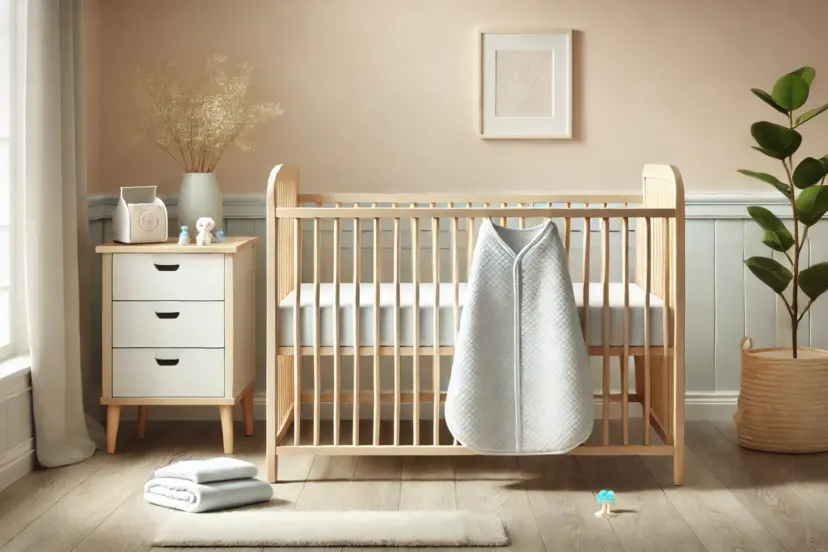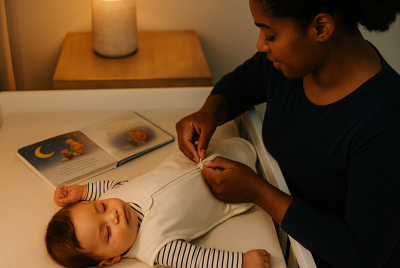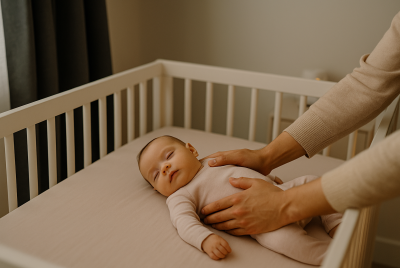Sleep Sack Baby: Your Cozy Guide to Baby Sleep Magic
We may earn a commission for purchases made using our links. Please see our disclosure to learn more.
We all understand the struggle as parents: endless nights spent hoping our children sleep soundly (and hopefully, get some sleep too!). There seem to be an endless number of options available, ranging from blankets to swaddles. And if you’re like the majority of parents nowadays, you’ve undoubtedly heard of the term “sleep sack” and perhaps questioned whether it’s actually what it seems.
So, what’s the deal with sleep sacks? Let’s dive into this cozy world and figure out what makes them so beloved by parents everywhere.
What Exactly is a Sleep Sack?
Consider a sleep sack as a comfortable, tiny sleeping bag designed specifically for infants. With this wearable blanket, you can keep your infant warm and comfortable without having to worry about loose blankets in the crib. Imagine a zip-up bag that is safe, snug, and secure, covering their torso and legs while allowing their arms and head to remain free. And what’s fantastic? It remains in place all night. (No more slinking in to fix a kicked-off blanket at three in the morning!)
Sleep sacks come in all kinds of styles, from lightweight cotton for warmer nights to plush fleece for the chilly months. There’s something for every baby and every season.
Why Sleep Sacks Are Every Parent’s Secret Weapon
Sleep sacks are becoming more and more popular for a reason. First of all, there are no loose blankets that could cover your baby’s face, making them incredibly safe. Once you zip them up, you can rest easy knowing your child is completely safe and snug.
Then there is the element of comfort. Because a sleep sack simulates a soft hug, babies appear to enjoy how cozy it is. Wouldn’t you feel safer if you were wrapped in a warm, cozy blanket? Additionally, sleep sacks help control body temperature, so you can forego additional layers and simply let your baby snuggle or relax.
A Little History on Sleep Sacks
The sleep sack idea isn’t particularly novel. Wearable blankets, a sort of parent hack for warmth without the hassle of blankets, have been popular in Europe for decades. As more parents searched for safe and warm ways to keep their infants warm, the concept gained popularity in the United States. They help babies sleep comfortably and safely, making them a popular choice for many families worldwide today.
Sleep Sack vs. Swaddle: What’s the Big Difference?
So you might be thinking: isn’t a sleep sack just like a swaddle? Not quite! Both are designed to help babies sleep, but they have different vibes. A swaddle wraps babies up tightly, especially around the arms, which helps newborns feel like they’re back in the womb (so calming for them). It also helps reduce that startle reflex that often wakes babies up.
Sleep sacks, on the other hand, are looser and give babies more freedom to move their arms and legs. Most parents switch to sleep sacks when their baby shows signs of rolling over — usually around 2 to 3 months old. Once a baby can roll, it’s better for them to have their arms free so they can adjust their position safely.
When Can You Start Using a Sleep Sack?
The short answer? Once your baby starts rolling, usually around 2 to 3 months. This is when you’ll want to move from a swaddle to a sleep sack, giving them more freedom to move their arms and push up if needed.
Top Benefits of Using a Sleep Sack
Why do so many parents swear by sleep sacks? Here’s why:
- Safety First: No loose blankets means no worries about covering their face in the middle of the night. The sleep sack stays put.
- Comfort All Night: Babies seem to find comfort in the gentle pressure around them. It’s like a mini-hug all night long.
- Temperature Control: No more overheating or chills — the right sleep sack keeps them at a comfy temp, so you can stop checking if they’re too hot or too cold.
Exploring the Different Types of Sleep Sacks
Sleep sacks aren’t a one-size-fits-all deal. They come in different materials and styles, so you can find one that fits your baby’s needs and your climate:
- Fleece Sleep Sacks: These are super cozy for colder months and feel like wrapping up in a warm sweater.
- Cotton Sleep Sacks: Perfect for warmer weather, cotton sleep sacks are lightweight and breathable, helping prevent overheating.
- Weighted Sleep Sacks: If you’ve ever heard of weighted blankets, you’ll understand these. The gentle weight can help some babies feel extra secure and settled.
Finding the Right Size for Your Sleep Sack
Picking the right size is crucial for your baby’s comfort (and safety). Most sleep sacks are sized by age and weight, so double-check those recommendations. If it’s too big, it could bunch up around their face; if it’s too tight, it’ll restrict their movement. Aim for that sweet spot: snug but with enough room for your little one to kick and wiggle comfortably.
Choosing the Best Material for Comfort
Just like we all have favorite fabrics for our PJs, sleep sack material matters! Here are some popular picks:
- Cotton: Lightweight, breathable, and perfect for summer months or warmer climates.
- Muslin: A loose weave that’s gentle and breathable, muslin is another great option for babies with sensitive skin.
- Fleece: Ideal for colder weather, fleece sleep sacks keep things warm and cozy but may be too warm for summer.
(Pro tip: If your baby has sensitive skin, look for organic cotton or hypoallergenic fabrics to avoid irritation.)
Keeping Your Baby Comfortable in Their Sleep Sack
To keep things cozy, make sure your baby is dressed appropriately under the sleep sack. In warmer weather, a simple onesie might do the trick; in cooler months, footed pajamas can add an extra layer. Avoid overdressing, though — sleep sacks already provide some warmth, so balance is key.
And don’t worry if the sleep sack seems roomy at the bottom; babies don’t need a tight fit around the legs. In fact, some room is better, allowing their legs to move freely for natural hip development.
When to Move from Sleep Sack to Blanket
At some point, your little one will probably be ready for a traditional blanket. Most babies transition to blankets between 18-24 months, but it really depends on what works best for your family. Some parents find that their toddler still prefers the sleep sack, especially if they’re active sleepers who move around a lot at night.
Are Sleep Sacks Safe? Absolutely.
Yes, sleep sacks are safe! They’re actually recommended by many pediatricians because they remove the risk of loose blankets in the crib. They’re designed to stay below your baby’s head, ensuring they can breathe easily and sleep without obstructions.
Common Sleep Sack Mistakes to Avoid
We’ve all been there — trying to figure out what works best for our little ones. Here are a few mistakes to avoid with sleep sacks:
- Picking the Wrong Size: An ill-fitting sleep sack can be uncomfortable or even unsafe.
- Overdressing: It’s easy to forget that sleep sacks add warmth, so keep layers light.
- Ignoring Guidelines: Always follow age and weight guidelines to ensure the best fit.
Seasonal Sleep Sack Swaps
The temperature in your home changes throughout the year, so you may need different sleep sacks for different seasons. Cotton is great for summer, while fleece sleep sacks are ideal for winter. Swapping them out as needed keeps your baby comfortable and sleeping soundly year-round.
Can You Use a Sleep Sack for Daytime Naps?
Definitely! Sleep sacks aren’t just for nighttime. Using a sleep sack for naps can help reinforce that cozy sleep association, making it easier to get your baby down for daytime rest too.
Washing and Caring for Your Sleep Sack
Most sleep sacks are machine washable (score!), but check the care instructions to be safe. Avoid fabric softeners, as they can make the fabric less breathable. Keeping your baby’s sleep sack fresh and clean means they’re sleeping in a cozy, hygienic environment.
Worried About Overheating? Here’s How to Prevent It
Sleep sacks are designed to help regulate temperature, but it’s still possible for babies to overheat. Choose a TOG (thermal overall grade) rating that fits your room temperature. If you’re unsure, feel your baby’s neck to check — if it’s sweaty, they might be too warm.
On the Go? Bring the Sleep Sack!
Sleep sacks are easy to pack, lightweight, and bring a touch of home with you. If you’re traveling or staying somewhere new, a familiar sleep sack can help your baby settle in and sleep better in a new environment.
Signs It’s Time to Transition Out of the Sleep Sack
Eventually, your baby will outgrow their sleep sack. Here are a few signs they might be ready for a blanket instead:
- They’re consistently sleeping through the night with a blanket.
- They no longer fit comfortably in the largest sleep sack size.
How Many Sleep Sacks Should You Have?
Honestly, having two sleep sacks can be a lifesaver. Babies can be messy (we know this!), so having a backup means you’ll always have a clean sleep sack on hand for naps or bedtime.
TOG Rating: Why It Matters
The TOG rating tells you how warm a fabric is, which helps when choosing the right sleep sack for your baby. Low TOG ratings (like 0.5) are best for warm weather, while higher ratings (like 2.5) are great for cooler climates.
Tips for Transitioning from Swaddle to Sleep Sack
Making the switch from swaddle to sleep sack can be a smooth process. Start using the sleep sack for naps, letting one arm out at first, then both. Over time, your baby will get used to the new freedom, and before you know it, they’ll be happily snoozing away.
Are Sleep Sacks Worth the Cost?
Sleep sacks come in a range of prices, but they’re typically affordable and, in most cases, a worthy investment. The comfort and peace of mind they provide are priceless.
Can Older Babies Still Use Sleep Sacks?
Absolutely! Many older babies and toddlers continue to use sleep sacks because they enjoy the comfort. Some sleep sacks are even designed with foot openings, letting toddlers move freely while staying cozy.
Related Products for Infant Sleep Safety
In addition to sleep sacks, several products are designed to enhance safe and comfortable sleep for babies. Here are some popular options that align with pediatric safe sleep recommendations:
- Swaddles: Swaddling is often beneficial in the first few months to help calm babies and reduce the startle reflex, which can disrupt sleep. However, switching to a sleep sack or another option is advised once babies begin rolling over, typically around 2-3 months, to prevent risks associated with restricted movement.
- Firm Crib Mattresses: A firm, flat mattress in a crib or bassinet is recommended, as soft mattresses can increase the risk of suffocation. The mattress should fit snugly with only a fitted sheet on top, keeping the sleep space free of extra bedding or padding.
- Baby Sleepers and Onesies: Lightweight pajamas or onesies, especially those made from breathable materials like cotton, are perfect for layering under a sleep sack. They help regulate body temperature and provide additional comfort without adding unnecessary warmth.
- Pacifiers: While not directly related to sleep sacks or bedding, pacifiers can offer soothing effects and are associated with a lower risk of SIDS when used during nap or bedtime.
- Wearable Monitors: Although not endorsed for safe sleep assurance, some parents opt for wearable monitors that track breathing or movement. However, these are not substitutes for safe sleep practices and should not create a false sense of security.
Using these products as part of a safe sleep setup, along with sleep sacks, can help create a secure and comfortable environment for babies. Always follow established safety guidelines when introducing new products into your baby’s sleep routine.
Key Research and Guidelines on Sleep Sacks and Infant Sleep Safety
American Academy of Pediatrics (AAP) Guidelines: The AAP has consistently advocated for sleep sacks as a safer alternative to traditional blankets, especially for infants who are transitioning from swaddling. Sleep sacks reduce the risk of sudden infant death syndrome (SIDS) and suffocation by eliminating loose bedding. The AAP also recommends keeping sleep environments uncluttered — meaning no pillows, bumpers, or toys — and always placing babies on their backs to sleep. They advise against using weighted sleep sacks, as these can potentially lower oxygen levels and pose risks for developing infants.
Johns Hopkins Safe Sleep Initiatives: Johns Hopkins Medicine has incorporated sleep sacks into its hospital protocols for safe infant sleep, as part of a broader campaign to reduce sleep-related deaths. Their approach aligns with the “ABC” guidelines: babies should sleep Alone, on their Back, in a Crib. This model is designed to reduce SIDS risks by avoiding bed-sharing and using a firm, flat surface without any soft objects. Their research and advocacy have shown that sleep sacks are a reliable way to follow these guidelines, especially after a baby outgrows swaddling.
Cleveland Clinic Insights on Sleep Sack Safety: The Cleveland Clinic highlights that sleep sacks allow for healthy hip movement, unlike swaddling, which, if done too tightly, can impact hip development. Sleep sacks provide ample room for babies to move their legs, which supports healthy hip positioning and reduces risks associated with hip dysplasia, making them a beneficial option once a baby starts to roll over
In Summary
Sleep sacks are a fantastic sleep solution that offers warmth, comfort, and peace of mind. They’re a safe way to keep your baby cozy all night without the worry of loose blankets, and they make bedtime routines just a little bit easier.
5 FAQs About Sleep Sack Baby
- Can I use a sleep sack with a newborn?
- Sleep sacks are generally better suited for babies around 2-3 months old. For newborns, a swaddle might be the way to go.
- How do I know if my baby is too hot?
- Pick a sleep sack with the right TOG rating and dress your baby according to room temperature. Feel their neck to check — if it’s sweaty, they’re likely too warm.
- Can sleep sacks go in the washing machine?
- Most can! Just skip the fabric softener to keep them breathable.
- Is it safe to use a sleep sack if my baby rolls over?
- Yes! Sleep sacks allow arm movement, so it’s safe even if your baby rolls.
- When should I stop using a sleep sack?
- Most parents switch to a blanket around age two, but some toddlers enjoy sleep sacks longer. It’s all about your child’s comfort level.
Happy sleeping, parents — here’s to restful nights and cozy, comfy babies!




